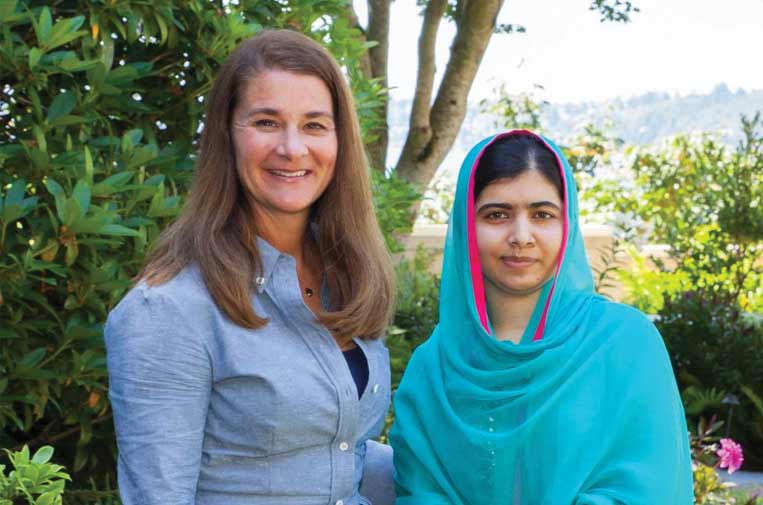
Women and solidarity: Female participation in philanthropy does not stop
New groups of women appear in different countries every year to organize social initiatives. Its objectives are to improve the living conditions of all, as well as to create networks of innovation and entrepreneurship in areas as diverse as education, culture, the environment or technology. They – who are advancing by leaps and bounds in the philanthropic area – are more generous, cooperative and related to their peers’ problems than men, according to the Center for Philanthropy at the University of Indiana (USA).
Rosa Madera @Rmadera6Rosa 16, 2019
The creation and dissemination of the 2030 Agenda of the United Nations Organization (UN) has contributed positively to the promotion and commitment of thousands of women entrepreneurs, as well as paving the way towards gender philanthropy, recognized as much more supportive and co-responsible
The concept of ‘equality’ appears in the Sustainable Development Goal No. 5 (SDG5) of the international entity. That is, symmetry to, on the one hand, balance the global balance of rights, duties and wealth distribution; and on the other, give equal power to men and women. How is this goal being achieved? Through education, information, knowledge and economic resources, says the organization.
While there are no official statistics on the percentage of women dedicated to philanthropy worldwide, the evidence shows that there are many and very varied and transversal sectors, for a very simple reason: they, in general, empathize much more with their peers than men, whether young, girls or in adulthood. Sex is related to empathy, as has been demonstrated in various studies (Davis, 1983; Eisenberg and Lennon, 1983; Mestre, Frías and Samper, 2004; Retuerto, 2004; Turnage et al 2012) and it is women who score the most high on the scales that measure it.
However, there is also a weak point to pay attention to. It is recognized that generally their initiatives do not have sufficient funds to carry out the objectives proposed, no matter how commendable they may be (Vid. Women entrepreneurs have more difficulty obtaining financing than men ). For this reason, the creation in 2007 of Women Moving Millions was fundamental. Since that year, the initiative has inspired more than 290 members to commit more than $ 600 million to organizations and initiatives that seek solutions to the problems of women and girls around the world.
Featured philanthropists
Under the logic described above, it is no coincidence that women are gaining prominence in philanthropy, one of the areas they handle not only because of their already noted empathy, but also because they are able to build more lasting support and coordination networks and with a more horizontal management that helps the commitment to its causes.
Among the cases of known philanthropist women is that of Melinda Gates, who founded with her husband the Bill and Melinda Gates Foundation in 2000, dedicated to promoting equality in education and health, among other issues. Gates has championed the fight against the gender gap that exists in the salaries of the technology sector.
Progressively other women from later generations and very diverse social environments have appeared. An example of this are the causes promoted by actress Emma Watson , who helps in the fight for equal opportunities for women, children and adolescents; activist Malala Yousafzai , who with her Fund supports the work of education advocates in developing countries and helps strengthen secondary education for girls around the world, or Drew Gilpin Faust , president of Harvard University, which devotes much of its research to issues about women, society and gender studies.
In 2016, Forbes magazine identified the 10 most powerful female philanthropists in the world, in areas such as finance, science, university, politics, technology companies, the film industry and large communication groups, among others. They are undoubtedly women with power, referents, with economic capacity and resources to invest in development and growth programs to help other women.
More recently, in the same magazine in its April 2019 edition, in an article developed by senior collaborator Bonnie Chiu, three women are described who are transforming philanthropy in the world, from the mere delivery of resources to the concept of ‘collaboration’.
The first one is Swatee Deepak, director of the With and For Girls collective , which committed a group of nine donors to provide flexible funds to grassroots organizations, run by girls and focused on them. Deepak, says the Forbes article , firmly believes that “a collaborative donation model can have a greater creative impact, because although at the beginning there are not always consensuses, the challenges in the area are much greater than egos.”
A second example is Freada Kapor Klein, president of the Kapor Center , one of the founding members of the Collaboration Fund for Women’s Safety and Dignity. One of the objectives of the Fund is to create cross-movement spaces for philanthropic members to learn from each other, share resources and develop strategies collaboratively.
And a third case is that of Kerrin Mitchell, co-founder and CEO of Fluxx , who assumed the commitment to connect the entire philanthropic ecosystem through a single network. They – Chiu explains – provided $ 7.2 billion in funds in 2018, working with leaders such as Microsoft, The Knight Foundation and Forefront.
The examples are increasingly recurring and continue to grow.
The big and simple difference
But what differentiates a woman from a man in this area? This is the question asked by Dr. Debra Mesch, in a study published in 2012 for the Center for Philanthropy at the University of Indiana (USA). The conclusion was simple: Women are more generous than men.
This year, the Women Give 2017: Giving makes us happy has been published in the same University, which shows that the issue of the influence of women as a social group – which contributes most in education and the global entrepreneurship of women and girls – keeps growing. The data is revealing, since it indicates that women tend to be more cooperative in work teams, orderly, methodical and with a deep social sense. These characteristics are inherent to them.
Meanwhile, the Women Give 2018: Transmitting Generosity to Daughters and Sons study reaffirms another important point. This shows how parents transmit generosity to their children, revealing that the relationship between fortunate parents and their female daughters is much stronger in the philanthropic area than those who have sons.
Apparently, philanthropy seems to be in the genre’s DNA. In a recent Morgan Stanley survey, 84% of women said they were interested in sustainable investment – which is defined here as an objective not only of financial performance but also of social or environmental objectives. In this same area, the figure for men was 67%.
If this data is taken, it is possible to agree with what Melinda Gates said then by stating that philanthropy was not just about money; It is about using the resources that people have at their disposal and applying them to improve the world. Due to the nature of the woman described above, it is deeply applicable to her initiatives.
Another revealing fact. The Economist, on the last International Women’s Day, said that the investment of women and in them is growing. In its pages it was reported that between 2010 and 2015 the private wealth of women grew from 34 to 51 trillion dollars. That is, it registered an increase of 50% in a very short time. In addition, we must consider – says the same source – that most of the private wealth that will change hands in the coming decades is probably for women.
Globally, the Women’s Collective Donor Network now has 47 donor circles, with more than 10,000 female philanthropists, who have understood that collaborative donation not only means giving together with other philanthropists with like-minded ideas, but also co-creating solutions for the people who need it.
Other realities
According to the Global Philanthropy Report of Harvard University 2018, there are more than 260,000 active foundations in the world. The United States concentrates 86 thousand of them, and Germany, another 20 thousand. While the difference with the rest of the countries, including Spanish-speaking countries, is very large, the gender perspective is not far behind.
For example, the Spanish Fundraising Association published in 2018 an x-ray of what is happening in this country regarding donations from non-profit entities. This report indicates that 9 out of 10 Spaniards of legal age have collaborated with a social cause.
Of this percentage, 86% have participated on occasion with different types of donations (clothing, food, etc.), and 55% economically, that is, with money. Tendency, this last figure is more feminine (52%) than masculine (48%).
Meanwhile, among the issues that most concern these donors are those related to childhood (49%), the elderly without family support (41%), the sick (38%) and women (34%).
According to the World Bank, one in eight people is a girl or a young woman from 10 to 24 years old, that is, 900 million people. However, less than 2 cents of every dollar spent on international aid goes to adolescents of this gender.
Investing in, for and for women seems to produce one of the best social returns. Hopefully, their initiatives will be highly valued and that when they concentrate more wealth, even more forceful changes can be seen.



